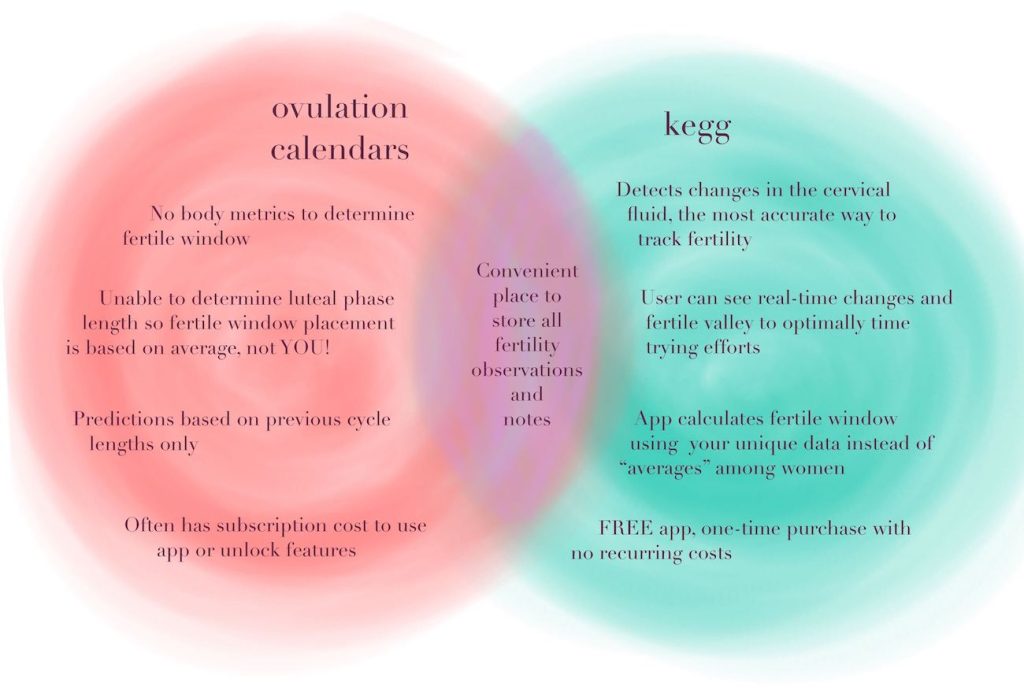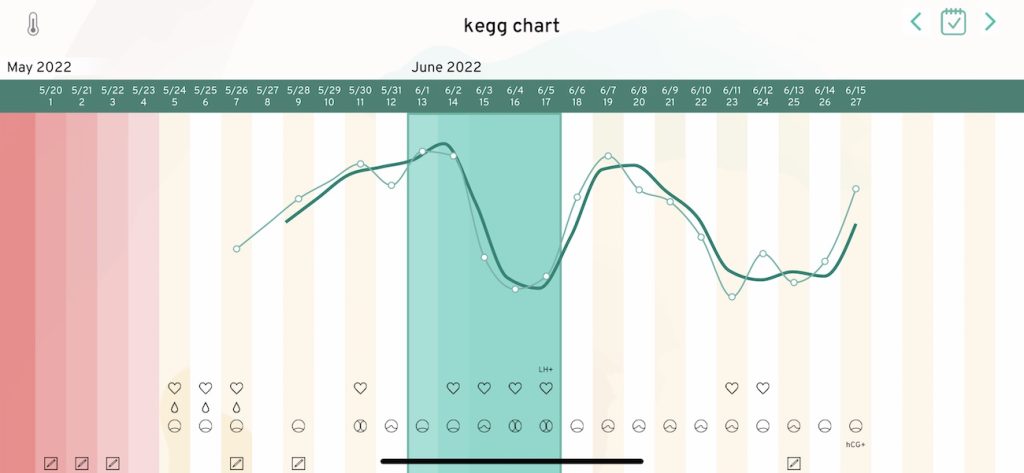Many women turn to ovulation calendars and period trackers when beginning their fertility journeys. It is a logical first step as it is a convenient way to record when your period starts and observations you may wish to make throughout your cycle. Let’s face it-recalling the date your period began and what days you observed cramps, spotting, had a headache, etc. can be challenging off the top of your head. The app Kindara, for example, allows the user to record their basal body temperature, cervical mucus observations, sex, OPK results (Ovulation Predictor Kit), and custom fields where the user can input personal observations they wish to make through the cycle. The calendar uses the period start date and your previous cycle length(s) to estimate when you will likely be fertile. Sounds straightforward, right?
As it turns out, it is a little “too straightforward” and simple, and as a result, not accurate. In fact, according to a 2018 study which looked at the accuracy of calendar based prediction methods, the accuracy of prediction of ovulation was no greater than 21%. When you consider that there is about a 1 in 5 chance the app will accurately predict your fertile window, it begins to feel like your predicted window is not much more than a shot in the dark.
As it turns out, it is a little “too straightforward” and simple, and as a result, not accurate. In fact, according to a 2018 study which looked at the accuracy of calendar based prediction methods, the accuracy of prediction of ovulation was no greater than 21%. When you consider that there is about a 1 in 5 chance the app will accurately predict your fertile window, it begins to feel like your predicted window is not much more than a shot in the dark.

Unfortunately, numerous factors influence when our fertile window will occur. Stress, illness, travel, medications, (should we just say life in general!?) all influence when our fertile window will actually unfold. While it is convenient to predict ovulation, we need to be aware that it is subject to change. The luteal phase length, or duration of time between ovulation and the start of the new cycle, is more fixed between cycles. However, this length of time varies greatly between women, as the normal luteal phase length extends from 11-17 days. In addition, many women have short luteal phase lengths, such as those with 8 or 9 day luteal phases.
To help illustrate how a calendar based app works, let’s take a look at an example. Alice has fairly regular cycle lengths, varying between 27-32 days in length. During her first cycle using an ovulation predictor app, she records that her period began 32 days after the start of the previous cycle. Her calendar app estimates her fertile window fell during cycle days 16 through 20. Unfortunately, the calendar algorithm assumes that Alice has an average luteal phase length of 12 days. Alice actually has a 15 day luteal phase length, which means her true fertile window likely fell from cycle days 13-17. The app predicts that her next cycle will be 32 days in length, and that her fertile window will again fall between cycle days 16 through 20. Alice times her trying to conceive efforts according to the predicted fertile window. She starts her next cycle 28 days after the start of her previous cycle. Since her luteal phase length is 15 days, this means her actual fertile window likely fell cycle days 9-13. Unfortunately, Alice does not get pregnant this cycle. She did not have sex during her true fertile window as she timed her efforts during the app’s prediction which fell after her true fertile window actually occurred.
Alice’s example highlights how the calendar method missed her fertile window. While having the true fertile window occurring a few days off from the predicted fertile window seems minimal, if intercourse or insemination are not timed during the true fertile window, conception is not possible for that cycle. When you’re trying to conceive, every cycle counts!
Problem Solved with kegg
kegg works differently. kegg detects the changes in the cervical fluid which shift throughout the cycle in only 2 minutes a day, at your preferred time (morning or evening). kegg’s algorithm tracks your cycle patterns to predict in advance when your fertile window will likely occur. While you have this fertile window prediction to guide you, the real-time readings allow the user to watch their fertile window unfold so they can see precisely when the fertile window is opening. With kegg, timing your intimacy when you are trying to conceive is not left up to a numerical calendar system or chance. Instead, you feel confident knowing your efforts are timed appropriately.
The fertile window appears as a valley. In the example below, the user saw her readings begin to descend on her kegg chart, which was the indication that she was entering her fertile valley, and occurred during her fertile window prediction. The descending and low readings are associated with a vaginal environment that is hospitable to sperm. This means that not only are you assured you are timing your efforts during the fertile window, you recognize that your vaginal environment is prepared to nourish and sustain the sperm while they await the release of the egg. Since more pregnancies result from trying in the days before ovulation than ovulation day itself, with kegg, users are able to optimally time their efforts without missing the valuable days that precede ovulation.
The fertile window appears as a valley. In the example below, the user saw her readings begin to descend on her kegg chart, which was the indication that she was entering her fertile valley, and occurred during her fertile window prediction. The descending and low readings are associated with a vaginal environment that is hospitable to sperm. This means that not only are you assured you are timing your efforts during the fertile window, you recognize that your vaginal environment is prepared to nourish and sustain the sperm while they await the release of the egg. Since more pregnancies result from trying in the days before ovulation than ovulation day itself, with kegg, users are able to optimally time their efforts without missing the valuable days that precede ovulation.

kegg users also have the added benefits of the other tracking options, similar to calendar based ovulation calculators or calendars. For example, kegg users can optionally input their LH and PdG test results, cervical mucus observations, basal body temps (which can be viewed with kegg data simultaneously), intercourse/insemination, spotting, etc. This makes it convenient to keep track of all of your fertility observations and data in one convenient app. Additionally, the app provides helpful fertility articles should you want to learn more to help you on your fertility journey.
The Bottom Line
While it seems handy that you can download an ovulation predictor or ovulation calculator app to determine when you are fertile, they do not track your unique fertility resulting in missed opportunities to try to conceive. Knowing your full fertile window and optimally timing your efforts can quadruple your chances of getting pregnant. Use calendar apps for helping you remember to visit the dentist, take the dog to the groomer, and schedule a spa visit, but don’t leave your fertility up to chance. With kegg, you can be confident you are perfecting your timing to maximize your chances of conceiving every cycle.
References: Johnson, S., Marriott, L.,Zinaman, M. Can apps and calendar methods predict ovulation with accuracy? https://pubmed.ncbi.nlm.nih.gov/29749274/
References: Johnson, S., Marriott, L.,Zinaman, M. Can apps and calendar methods predict ovulation with accuracy? https://pubmed.ncbi.nlm.nih.gov/29749274/
